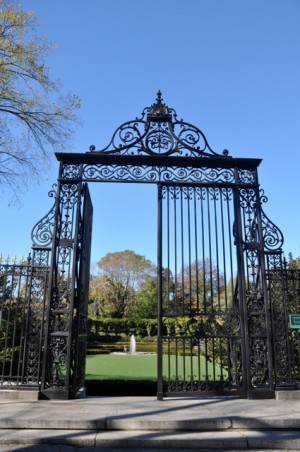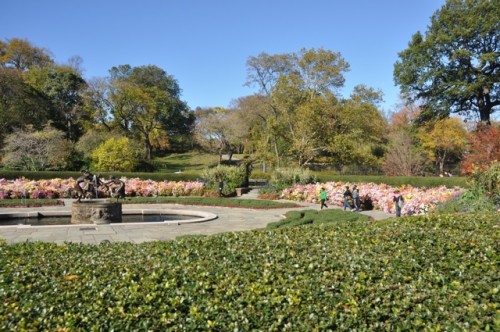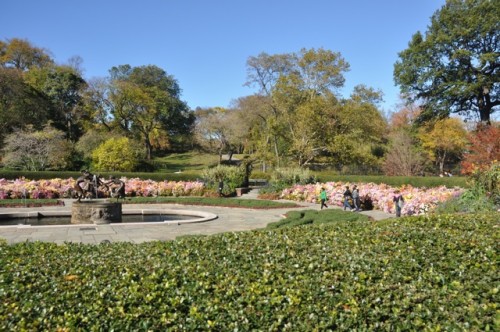 Lynden Miller can see Central Park from her window.Photo: Sarah GoodyearIt is a perfect fall day in the Conservatory Garden in New York’s Central Park. A group of teenagers are playfully pushing each other around at the edge of a sparkling fountain. An older lady sits on a bench, eyes closed, face turned to the sun. A profusion of chrysanthemums sways in the breeze. People of all ages and colors wander the garden’s paths. Improbably, a woman is walking two rabbits on leashes along the flowerbeds.
Lynden Miller can see Central Park from her window.Photo: Sarah GoodyearIt is a perfect fall day in the Conservatory Garden in New York’s Central Park. A group of teenagers are playfully pushing each other around at the edge of a sparkling fountain. An older lady sits on a bench, eyes closed, face turned to the sun. A profusion of chrysanthemums sways in the breeze. People of all ages and colors wander the garden’s paths. Improbably, a woman is walking two rabbits on leashes along the flowerbeds.
Thirty years ago, this place was filled with trash, from shopping carts to used condoms. Its stone walls were covered in graffiti. Its flowerbeds were bare, its hedges overgrown.
That was before Lynden Miller showed up.
In 1982, Miller was tapped by Betsy Rogers, the head of the newly formed Central Park Conservancy, to remake the garden, which had been neglected for many years. Miller’s mandate was to raise the money needed to restore what had once been a lovely formal garden, and to then bring people to it. She raised the money for the garden in what she calls “the old-fashioned woman’s way,” by soliciting donations from well-connected and well-heeled friends. And when she built it, people came.
At the time, Miller was a painter who gardened on the side. She thought it would be a one-time assignment, but instead it was a revelation.
 Thirty years ago, the Conservatory Garden was a trash-strewn wasteland. Then Lynden Miller showed up.Photo: Sarah Goodyear“When you saw the reactions of people of all kinds to something beautiful, I realized that I had stumbled on something that really moved me,” said Miller during a recent interview at her apartment on Fifth Avenue, which has a commanding view of Central Park. “To be able to make something beautiful for people I’ll never know, and improve my city, was a lot more attractive than going back to my studio.”
Thirty years ago, the Conservatory Garden was a trash-strewn wasteland. Then Lynden Miller showed up.Photo: Sarah Goodyear“When you saw the reactions of people of all kinds to something beautiful, I realized that I had stumbled on something that really moved me,” said Miller during a recent interview at her apartment on Fifth Avenue, which has a commanding view of Central Park. “To be able to make something beautiful for people I’ll never know, and improve my city, was a lot more attractive than going back to my studio.”
Miller has written a book, Parks, Plants, and People: Beautifying the Urban Landscape, about what she learned in the Conservatory Garden and more than two dozen subsequent projects in New York, including Bryant Park, Madison Square Park, and Wagner Park. Despite the lovely flowers on the cover, the book is not meant for gardeners. It’s meant for planners and activists who want to create high-quality green spaces in urban settings. It contains plenty of advice about plants, but also about funding, advocacy, and volunteer recruitment. Throughout, Miller hammers home her point that beautiful parks nurture the best qualities of a city and its people. The book’s final words sum up her philosophy: “Make it gorgeous and they will come; keep it that way and they will help you.”
It’s a message she has taken on the road to cities all around the country, and it is, at its core, very simple. “Every human being responds to a connection with nature,” said Miller. “People of all kinds love something beautiful and will talk to each other when they see it. They change the way they behave. It changes the way they feel about themselves and each other.”
 A walk in the park.Photo: Sarah GoodyearMiller also believes that creating high-quality parks and gardens is a powerful tool for economic development and urban improvement. Here’s how she put it when she was talking to the mayor of Detroit: “This is the cheapest date in town. This is the easiest way to fix up your city.” Too often, she said, a city’s parks budget is the first thing to get cut. “It should be the last,” she said. If a city’s parks are neglected, she argued, the people believe that the city doesn’t care about them, and the social fabric begins to fray.
A walk in the park.Photo: Sarah GoodyearMiller also believes that creating high-quality parks and gardens is a powerful tool for economic development and urban improvement. Here’s how she put it when she was talking to the mayor of Detroit: “This is the cheapest date in town. This is the easiest way to fix up your city.” Too often, she said, a city’s parks budget is the first thing to get cut. “It should be the last,” she said. If a city’s parks are neglected, she argued, the people believe that the city doesn’t care about them, and the social fabric begins to fray.
Miller, 71, is a white-haired patrician beauty, soft-spoken and polite. But she is also persistent. During our interview, she referred repeatedly to how she “drives people nuts” if she has a project that she wants to get done.
“What’s great about her is she’s a hands-on type of person,” said Greg O’Connell, a real estate developer who hired Miller to create a garden on property he owns in Red Hook, on the Brooklyn waterfront. “She gets her hands dirty. And she’s so right about greenery and landscaping, and how people need it. She opened my eyes to how important it is to any type of commercial development.”
Back in 1982, the idea of a white, well-to-do woman spending her time and effort on a project in the northern end of Central Park — with the projects of East Harlem just a block away — was enough to scandalize some of Miller’s friends.
 Today, the Conservatory Garden is one of the city’s treasures.Photo: Sarah Goodyear“Half the people you knew wouldn’t go above 79th Street without an armed escort,” Miller said, shaking her head. “The Conservatory Garden was on 105th Street. People kept saying to me, you’re crazy, you’re going to get raped and maimed in there.” When instead the completed garden succeeded in drawing peaceful, happy crowds to the park’s northern end, said Miller, “It broke all those rules. It showed us that we were not giving enough credit to our fellow human beings.” What is needed in today’s New York, Miller believes, is a rehabilitation of parks in the city’s poorest neighborhoods, like East New York.
Today, the Conservatory Garden is one of the city’s treasures.Photo: Sarah Goodyear“Half the people you knew wouldn’t go above 79th Street without an armed escort,” Miller said, shaking her head. “The Conservatory Garden was on 105th Street. People kept saying to me, you’re crazy, you’re going to get raped and maimed in there.” When instead the completed garden succeeded in drawing peaceful, happy crowds to the park’s northern end, said Miller, “It broke all those rules. It showed us that we were not giving enough credit to our fellow human beings.” What is needed in today’s New York, Miller believes, is a rehabilitation of parks in the city’s poorest neighborhoods, like East New York.
During our entire interview, Miller kept a notepad in front of her, and was constantly jotting down ideas for people to contact, things to do, ways to spread the lesson she learned 30 years back in the Conservatory Garden.
“Where would we be without these lovely places?” she wondered aloud. “They are talking to people’s souls. They are sanctuaries for the soul.”


